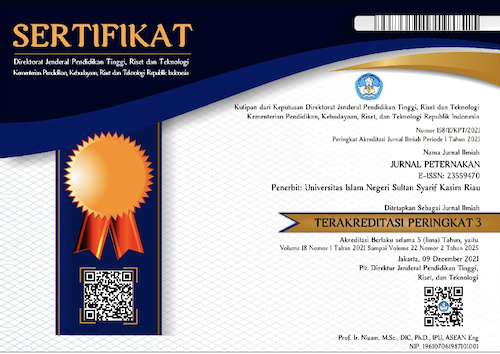Nutrition Mass of Fermented Coconut Pulp with Rumen Fluid as Poultry Feed
Abstract
The use of coconut pulp as animal feed is still limited due to the high content of crude fat and crude fiber, which are difficult to digest by livestock and low palatability, so feed processing technology is needed, one of which is through the fermentation process with the addition of microorganisms from rumen fluid. This study aimed to determine the nutritional quality of coconut (Cocos nucifera l.) pulp with different fermentation lengths using Bali cow rumen fluid. The study used a completely randomized design (CRD) consisting of 3 treatments and 4 replicates. The treatments used in this study were AA = 0-day coconut pulp (control), AB = 5-day fermented coconut pulp, and A2 = 7-day fermented coconut pulp. The variables observed were dry matter (DM), crude protein (CP), crude fiber (CF), and crude fat (FF). The results showed a significant effect (P<0.05) on the mean values of BK AA (94.669±0.33) AB (91.89±0.23) and AC (90.46±0.44), PK AA (5.33±0.41), AB (6.00±0.14) and AC (6.59±0. 15), SK AA (16.99±0.31), AB (10.16±0.21), and AC (9.24±0.24) and showed no significant effect (P>0.05) on the mean value of LK AA (44.55±0.50), AB (44.52±0.3), and AC (43.29±0.58). Based on the results of the study, it was concluded that 7-day fermentation decreased BK, LK, and SK and increased PK of coconut pulp. The best fermentation time of coconut pulp with Bali cow rumen fluid is on day 7.
Keywords
Full Text:
PDFReferences
Aminah, S., L. K. Nuswantara, B. I. M. Tampoebolon, and Sunarso. 2020. Peningkatan kualitas sabut kelapa melalui teknologi fermentasi menggunakan mikroba pencerna serat terseleksi dari cairan rumen kerbau. Sains Peternakan 18(1):44. doi: 10.20961/sainspet.v18i1.35976.
AOAC. 2005. AOAC Official Methods of Analysis 16th edition volume II. Association of Official Agricultural Chemists. Washington D.C.
Bachruddin, Z. 2018. Teknologi Fermentasi Pada Industri Peternakan. Universitas Gadjah Mada.
Fadhilah, I.N., V.Octaviani2, N. Kurniasih. 2022. Nilai nutrisi (analisis proksimat) ampas kelapa terfermentasi sebagai pakan kelinci. Gunung Djati Conference Series, Volume 7: 83-88.
Heryani, E., E. Kardaya, D. Sudrajat. 2017. Kualitas Isi Rumen Sapi Hasil Fortifikasi Dan Fermentasi. Jurnal Peternakan Nusantara 1(1):49–56.
Kurniawan, H. 2016. Kualitas nutrisi ampas kelapa (Cocos Nucifera L.) fermentasi menggunakan Aspergillus Niger. Buletin Peternakan 40(1):25. doi: 10.21059/buletinpeternak.v40i1.9822.
Laksono, J., T. Karyono, H. Haniati. 2023. Nilai nutrisi ampas kelapa ( Cocos Nucifera L. ) yang di fermentasi menggunakan Aspergillus Niger dengan waktu berbeda sebagai ransum ternak unggas. Jurnal Ilmu dan Teknologi Peternakan Indonesia Volume 9 (1) 42 - 48.
Mahanani, A.A., I. H. Djunaidi , O. Sjofjan. 2020. Nutrient content of cocoa husk by cellulose treatment. International Research Journal of Advanced Engineering and Science Volume 5 (1) 270-273
Melzana, I., Safika, Darmawi, Erina, and Al Azhar. 2020. Isolate of bacterial cellulase enzyme production in the rumen of aceh cattle based on analysis homology 16S RRNA. Jurnal Medika Veterinaria 14(2):174–82.
Nusantara, M. J., R. Sutrisna, M. Muhtarudin, and Liman. 2022. Pengaruh campuran daun singkong onggok fermentasi menggunakan Aspergillus Niger terhadap bahan kering, abu, bahan organik, serat kasar, dan protein kasar. Jurnal Riset dan Inovasi Peternakan 6(4):418–29.
Purnomohadi, M. 2006. Peranan bakteri selulotik cairan rumen pada fermentasi jerami padi terhadap mutu pakan. J. Protein. 3: 108-114.
Rahayu, E. P., D. Saefulhadjar, and H Supratman. 2023. Perubahan kandungan protein kasar dan bahan kering pada kacang kedelai yang difermentasi dengan probiotik heryaki cair.” Jurnal Sumber Daya Hewan 4(1):17–20. doi: 10.24198/jsdh.v4i1.48605.
Singgih, S., S. Rahayu, and M. Bata. 2013. Kecernaan neutral detergent fiber (NDF), acid detergent fiber (ADF) dan serat kasar pakan kerbau berbasis jerami padi. Jurnal Ilmiah Peternakan 1(2):546–53.
Suwitari, N. K. E., L. Suariani, N. M. Yudiastari, N. Kaca, and Y. Tonga. 2019. Performance of 0-14 weeks-aged super free-range hens that are fed by fermented coconut pulp flour- contained ration performance of 0-14 weeks-aged super free-range hens that are fed by fermented coconut pulp flour-contained ration. Journal of Physics : Conferences series (4th Annual appllied science and engineering science) 1402 055027.doi: 10.1088/1742-6596/1402/5/055027.
Thierry, N. N., T. N. Léopold, M. Didier, and F. M. C. Moses. 2013. Effect of pure culture fermentation on biochemical composition of moringa oleifera lam leaves powders. Food and Nutrition Sciences, 4 : 851-859.
Vilan, E. E., T. Dodu, and I. M. S. Aryanta. 2023. Pengaruh penggunaan ampas kelapa (Cocos Nucifera L) fermentasi dalam ransum terhadap kecernaan bahan kering dan bahan organik babi grower-finisher. Jurnal Nukleus 10(1): 50– 58.
Zuraida , D. Jusadi, N. B. P. Utomo. 2013. Efektivitas penambahan enzim cairan rumen domba terhadap penurunan serat kasar bungkil kelapa sebagai bahan baku pakan ikan. Jurnal Akuakultur Rawa Indonesia, 1(2) :117-126.
DOI: http://dx.doi.org/10.24014/jupet.v21i1.26340
Refbacks
- There are currently no refbacks.
Jurnal Peternakan has been accredited by Sinta 3 : Number 158/E/KPT/2021
Starting from Vol. 18 No. 1 Year 2021 to Vol. 22 No. 2 Year 2025
Jurnal Peternakan Indexed By:
Editorial Office:
Jurnal Peternakan
Faculty of Agriculture and Animal Science, State Islamic University of Sultan Syarif Kasim Riau.
H.R. Soebrantas street KM. 15,5 Panam – Pekanbaru city.
E-mail: jurnal.peternakan@uin-suska.ac.id
ejournal: http://ejournal.uin-suska.ac.id/index.php/peternakan

Creation is distributed under the Creative Commons Attribution 4.0 International License. View Mystats














